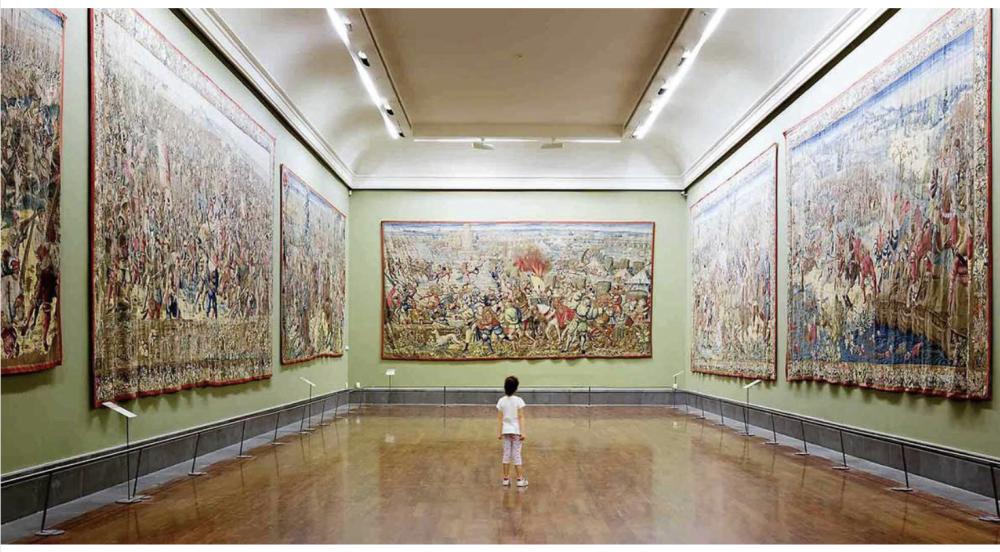Il sito nasce come riserva di caccia di Re Carlo ed è stato residenza reale per tre dinastie, ognuna delle quali ha lasciato un segno: i Borbone, i sovrani francesi Giuseppe Bonaparte e Gioacchino Murat e i Savoia dopo l′unità di Italia. Nel percorso si attraversano ambienti sfarzosi, come la Sala della Culla e il Salone delle Feste, e luoghi privati come l′alcova pompeiana. E poi ritratti di famiglia, oggetti d′arte e di arredo e prodotti di lusso delle manifatture borboniche quali porcellane, armi, sete e arazzi. Il MUSEO ha inizio con la Collezione Farnese, già famosa nel Cinquecento, che Carlo di Borbone eredita dalla madre e porta con sé a Napoli nel 1735, desiderando di sistemarla in questa reggia in collina. Nel tempo, la collezione si arricchisce con le acquisizioni delle famiglie reali, con le opere provenienti da chiese e conventi napoletani, con importanti doni da parte di collezionisti privati. Tra Sette e Ottocento Capodimonte diviene tappa obbligata del Grand Tour dItalia, durante il quale giovani intellettuali e aristocratici provenienti dai paesi europei visitavano la reggia per goderne le bellezze artistiche e naturali. Il REAL BOSCO, con i suoi 134 ettari e più di 400 specie vegetali, costituisce un′area verde incontaminata che si affaccia sulla città e sul golfo di Napoli. Grazie al clima mite e all′attività di rinomati botanici, qui si impiantarono molte specie rare ed esotiche tra le quali canfora e camelie provenienti dall′Asia, magnolie e taxodi delle Americhe ed eucalipti australiani. Tra i viali, disegnati con maestria da scenografo dall′architetto Ferdinando Sanfelice, si dispongono 16 edifici storici tra residenze, casini, laboratori, depositi e chiese, oltre a fontane e statue, orti e frutteti. Per il suo patrimonio storico, architettonico e botanico il Bosco di Capodimonte è stato nominato nel 2014 il parco più bello dItalia.
The site was born as a hunting reserve of King Charles and was the royal residence for three dynasties, each of which left a mark: the Bourbons, the French sovereigns Giuseppe Bonaparte and Gioacchino Murat and the Savoy after the unification of Italy. On the way you will pass through sumptuous environments, such as the Sala della Culla and the Salone delle Feste, and private places such as the Pompeian alcove. And then family portraits, objects of art and furniture and luxury products of Bourbon manufactures such as porcelain, weapons, silks and tapestries. The MUSEUM begins with the Farnese Collection, already famous in the sixteenth century, which Carlo di Borbone inherited from his mother and brought with him to Naples in 1735, wishing to arrange it in this palace on the hill. Over time, the collection is enriched with the acquisitions of royal families, with works from Neapolitan churches and convents, with important gifts from private collectors. Between the eighteenth and nineteenth centuries Capodimonte became an obligatory stop on the Grand Tour of Italy, during which young intellectuals and aristocrats from European countries visited the palace to enjoy its artistic and natural beauties. The REAL BOSCO, with its 134 hectares and more than 400 plant species, constitutes an uncontaminated green area overlooking the city and the Gulf of Naples. Thanks to the mild climate and the activity of renowned botanists, many rare and exotic species were planted here including camphor and camellias from Asia, magnolias and taxodes from the Americas and Australian eucalyptus. Among the avenues, designed with mastery by the scenographer by the architect Ferdinando Sanfelice, there are 16 historic buildings including residences, cottages, workshops, warehouses and churches, as well as fountains and statues, vegetable gardens and orchards. For its historical, architectural and botanical heritage, the Bosco di Capodimonte was named the most beautiful park in Italy in 2014.











